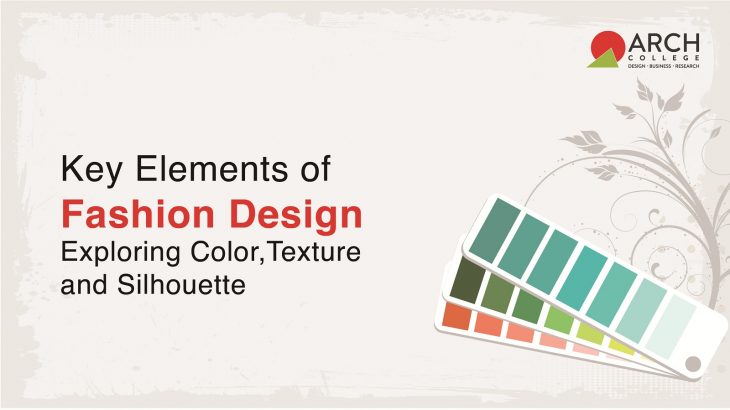Thinking if your niche of design and fashion can get you all you yearn for and pave the path for a high-paying career ahead?
You are not wrong if your perception is directed in this direction! Let’s get you through those amazing elements of fashion design that have uplifted the industry since its uprise.
A Look in the World of Design and Fashion
The elements and rules of design, which make up design features, can be thought of as the conceptual framework of art and design. With ARCH College of Design & Business, you can put together and align elements or features in a way that looks engaging and captivating as it stands out among the Best Fashion Design Colleges in India. Designing with them becomes the process of making a plan or set of rules for creating an item or model. Apparently, fashion design is the practical art of making clothes and items for everyday life that reflect the culture and society of a certain time.
Exploring the Designing Niche with Key Elements of Fashion Design
Fashion design is a dynamic field that is always changing. It involves a wide range of artistic skills and methods. Fashion designers are the mainstay and strength of our thriving culture. In this writing piece, we’ll look at the most important elements of the fashion industry that go into producing stylish and new aesthetics.
- Creativity and Inspiration
Imagination and inspiration are at the very core of fashion design. Fashion designers must have a good sense of style and be able to think beyond the ordinary. Get a Bachelor’s Degree in Fashion Design at ARCH College of Design & Business and expand your experience from coming up with ideas for clothes to making lines that look appealing. Designers get ideas from numerous sources like cultural heritage, nature, ages, and their own lives. By putting together various components and thoughts, designers can make patterns that are unique and differentiate out in the fashion world.
- Sketching and Illustration
Fashion designers need to draw and illustrate in order to show how they envision things to look. Sketching is how designers present their first ideas and turn them into pictures that can be seen. These sketches are used as a help to make the clothes and as a plan for how they should look. Fashion Designers add particulars, shades, and textures to these sketches to make them look more like the finished design.
- Fabric Choice and Intervention
The choice of fabric is very important to how an outfit looks and feels as a whole. Fashion makers carefully look at the texture, weight, shape, and longevity of different fabrics to figure out which one will work best with their design. They also try out different ways of intervening with fabric, like pleating, hanging, and gathering, to make forms and patterns that are unique.
- Color Theory and Choosing a Palette
Color has a big role in fashion design. It can make people feel different things and set the mood for a collection. Fashion designers learn about color theory and how different colors, tones, and shades work together. They make color choices that go well with their patterns and show the mood or message they want to communicate. Color choosing is very important to the success of a fashion line, no matter if the clothes are bright and bold or soft and subtle.
- Silhouette and Proportion
Silhouette and proportion are two of the most important parts of fashion design. They determine how a clothing looks and fits overall. Fashion makers look at the measurements, balance, and harmony of the body to make shapes that look good and fit well. They try out different cuts, forms, and patterns to make the body’s natural features look better or change them to create a certain look.
- Details and Embellishments
Details and embellishments give a piece of clothing depth and interest in appearance. Different methods, like stitching, beads, appliqué, and manipulating the fabric, are used by fashion designers to add intricate details to their designs. These details can turn a simple piece of clothing into a work of art by giving it a unique and personal touch.
- Skills and Garment Detailing
Fashion designers need to know how to make and fix clothes in order to make their ideas come to life. A Bachelor of Fashion Design will ensure that your ideas are useful and well-made, you’ll grab a lot of stuff about sewing, making patterns, and how clothes are put together. Strong abilities in technology would help the designer within you transform your creative ideas into garments that people can buy, wear and sell.
- Trend Recognition and Adaptability
Fashion designers have to keep up with current fashions and customer interests. To remain ahead of the curve, they always examine and analyse on fashion estimates, ramp shows, street fashion, and internet trends. But it’s just as important for designers to change and rework these trends to fit their own style and the people they want to reach. In the fashion business, which is always evolving, it is important to find the right mix between new ideas and things that will sell.
Wrapping Up
Give a blooming start to your journey of fashion and design with innovative programs for the aspirants in B. Des (UG, 4 yr), Masters in Design Entrepreneurship (PG, 2 yr), BA International (2+1+1) and the Fashion Design one year Professional Course with no one else but ARCH College of Design & Business and witness your career scale up over the years!
